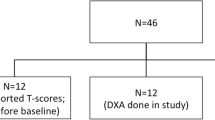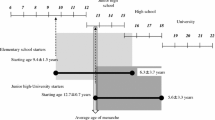Summary
The aim of this study was to compare the effects of intense endurance vs strengthening exercise on bone mass and serum testosterone levels in male athletes. Bone mineral density (BMD) of the total body and spine and serum testosterone levels were measured in male rowers (n=12), triathletes (n=8) and sedentary controls (n=13). The total body scan also gave values for percentage body fat and regional bone densities. Calcium intake and physical activity levels were measured by questionnaire. The rowers had significantly higher BMD in the spine and total body than the triathletes (P < 0.01 and P < 0.05 respectively) and sedentary controls (P < 0.01 and P < 0.05). There were no differences between the triathletes and controls. Serum testosterone levels were significantly lower in the triathletes than in the controls (P < 0.05); there was no significant difference between the rowers and controls. All groups fell within the normal range for testosterone. In a step-wise multiple regression, including age, body mass, height, calcium intake and activity, no single factor had a significant effect on spine BMD. Body mass had a significant effect on total body BMD and could account for the differences between the groups. A significant positive correlation was found between calcium intake and total body BMD. The heavy weight training typical of rowing training seemed to result in significant bone accretion. The low testosterone levels in the triathletes may have negated any positive effect of the increased exercise on BMD.
Similar content being viewed by others
References
Bilanin JE, Blanchard MS, Russek-Cohen E (1989) Lower vertebral bone density in male long distance runners. Med Sci Sports Exerc 21:66–70
Carbon RJ (1992) Exercise, amenorrhoea and the skeleton. Br Med Bull 48:546–560
Christiansen C, Riis BJ (1990) Postmenopausal osteoporosis: a handbook for the medical professions. The National Osteoporosis Society and the European Foundation for Osteoporosis and Bone Disease. pp 27–32
Cumming DC, Wheeler GD, McColl EM (1989) The effects of exercise on reproductive function in men. Sports Med 7:117
Department of Health (1991) Dietary reference values for food energy and nutrients for the United Kingdom. Report on Health and Social Subjects 41, HMSO, London
Drinkwater BL, Nilson K, Chesnut CH, Bremner WJ, Shainholtz S, Southworth MB (1984) Bone mineral content of amenorrheic and eumenorrheic athletes. New Engl J Med 311:277–280
Foresta C, Ruzza G, Mioni R, Guarneri G, Gribaldo R (1984) Osteoporosis and decline of gonadal function in the elderly man. Horm Res 19:18–22
Hetland ML, Haarbo J, Christiansen C (1992) Bone loss in male runners. Bone Miner 17:S73
Loucks AB (1990) Effects of exercise training on the menstrual cycle: existence and mechanisms. Med Sci Sports Exerc 22:275–280
Loucks AB, Vaitukaitis J, Cameron JL, Rogol AD, Skrinar G, Warren MP, Kendrick J, Limacher MCV (1992) The reproductive system and exercise in women. Med Sci Sports Exerc 24:5288–5293
MacDougall JD, Webber CE, Martin J, Ormerod S, Chesley A, Younglai EV, Gordon CL, Blimkie OR (1992) Relationship among running mileage, bone density, and serum testosterone in male runners. J Appl Physiol 73:1165–1170
Marcus R, Cann C, Madvig P, Minkoff J, Goddard M, Bayer M, Martin M, Gaudiani L, Haskell W, Genant H (1985) Menstrual function and bone mass in elite women distance runners. Ann Int Med 102:158–163
Margulies JY, Simkin A, Leichter I, Bivas A, Steinberg R; Giladi M, Stein M, Kashtan H, Mulgrom C (1986) Effect of physical activity on the bone-mineral content in lower limbs of young adults. J Bone Joint Surg 68:1090–1093
Mazess RB, Barden HS, Bisek JP, Hanson J (1990) Dual-energy X-ray absorptiometry for total-body and regional bone-mineral and soft-tissue composition. Am J Clin Nutr 51:1106–1112
Nelson M, Hague GF, Cooper C, Bunker VW (1988) Calcium intake in the elderly. J Hum Nutr Dietet 1:115–127
Nelson M, Mayer AB, Rutherford O, Jones D (1991) Calcium intake, physical activity and bone mass in pre-menopausal women. J Hum Nutr Dietet 4:171–178
Nilsson BE, Westlin NE (1971) Bone density in adults. Clin Orthop 77:179–182
Rigotti NA, Neer RM, Jameson L (1986) Osteopenia and bone fractures in a man with anorexia nervosa and hypogonadism. JAMA 256:385–388
Rutherford OM (1990) The role of exercise in the prevention of osteoporosis. Physiotherapy 76:522–526
Rutherford OM (1993) Spine and total body mineral density in amenorrhoeic endurance athletes. J Appl Physiol 74:2904–2908
Urhausen A, Kullmer T, Kindermann W (1987) A 7-week followup study of the behaviour of testosterone and cortisol during the competition period in rowers. Eur J Appl Physiol 56: 528–533
Vervoorn C, Quist AM, Vermulst LJM, Erich WBM, deVries WR, Thijssen JHH (1991) The behaviour of the plasma free testosterone/cortisol ratio during a season of elite rowing training. Int J Sports Med 12:257–263
Wheeler MJ, Luther F (1983) Development of testosterone radioimmunoassays for routine use. In: WH Hunter, JET Corrie (eds) Immunoassays for clinical chemistry. Churchill Livingstone, Edinburgh, pp 113–116
Wheeler GD, Wall SR, Belcastro AN, Cumming DC (1984) Reduced serum testosterone and prolactin levels in male distance runners. JAMA 252:514–516
Wolman RL, Clark P, McNally E, Harries M, Reeve J (1990) Menstrual state and exercise as determinants of spinal trabecular bone density in female athletes. Br Med J 301:516–518
Wolman RL, Faulman L, Clark P, Hesp R, Harries MG (1991) Different training patterns and bone mineral density of the femoral shaft in elite female athletes. Ann Rheum Dis 50:487–489
Author information
Authors and Affiliations
Rights and permissions
About this article
Cite this article
Smith, R., Rutherford, O.M. Spine and total body bone mineral density and serum testosterone levels in male athletes. Eur J Appl Physiol 67, 330–334 (1993). https://doi.org/10.1007/BF00357631
Accepted:
Issue Date:
DOI: https://doi.org/10.1007/BF00357631




